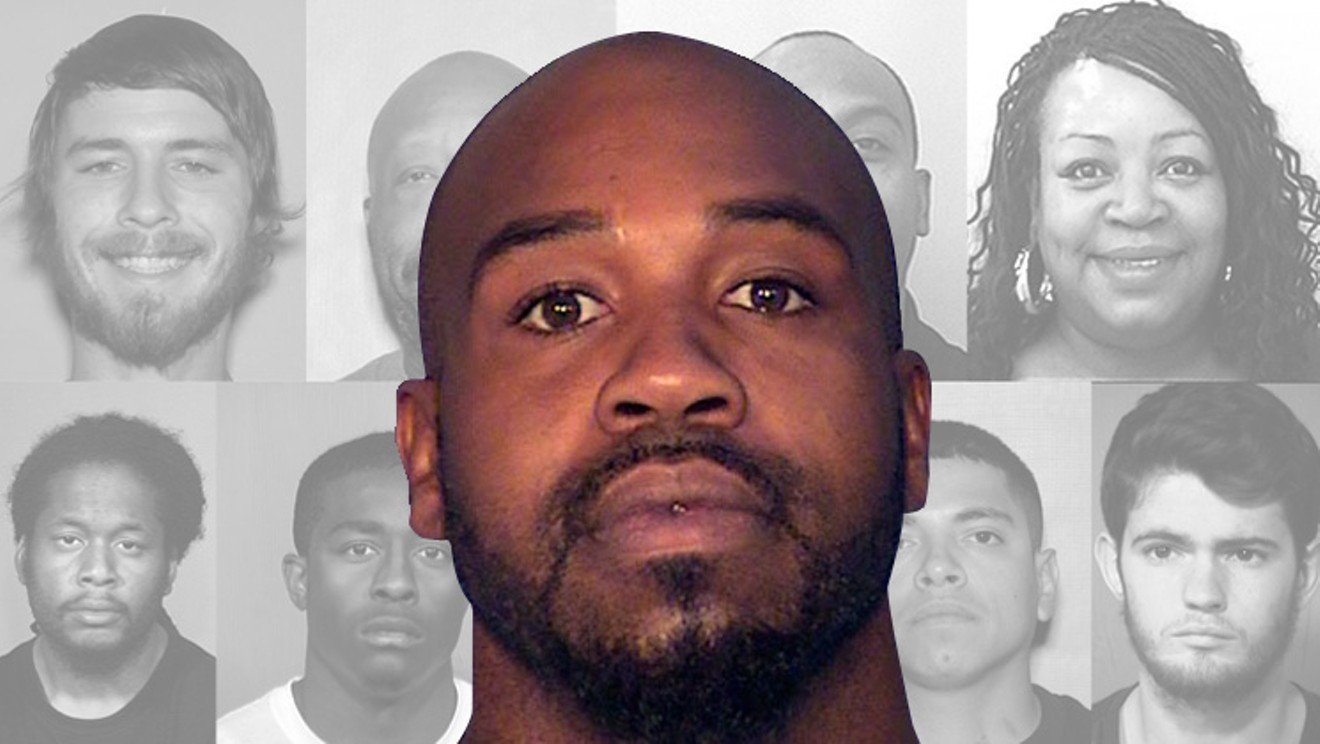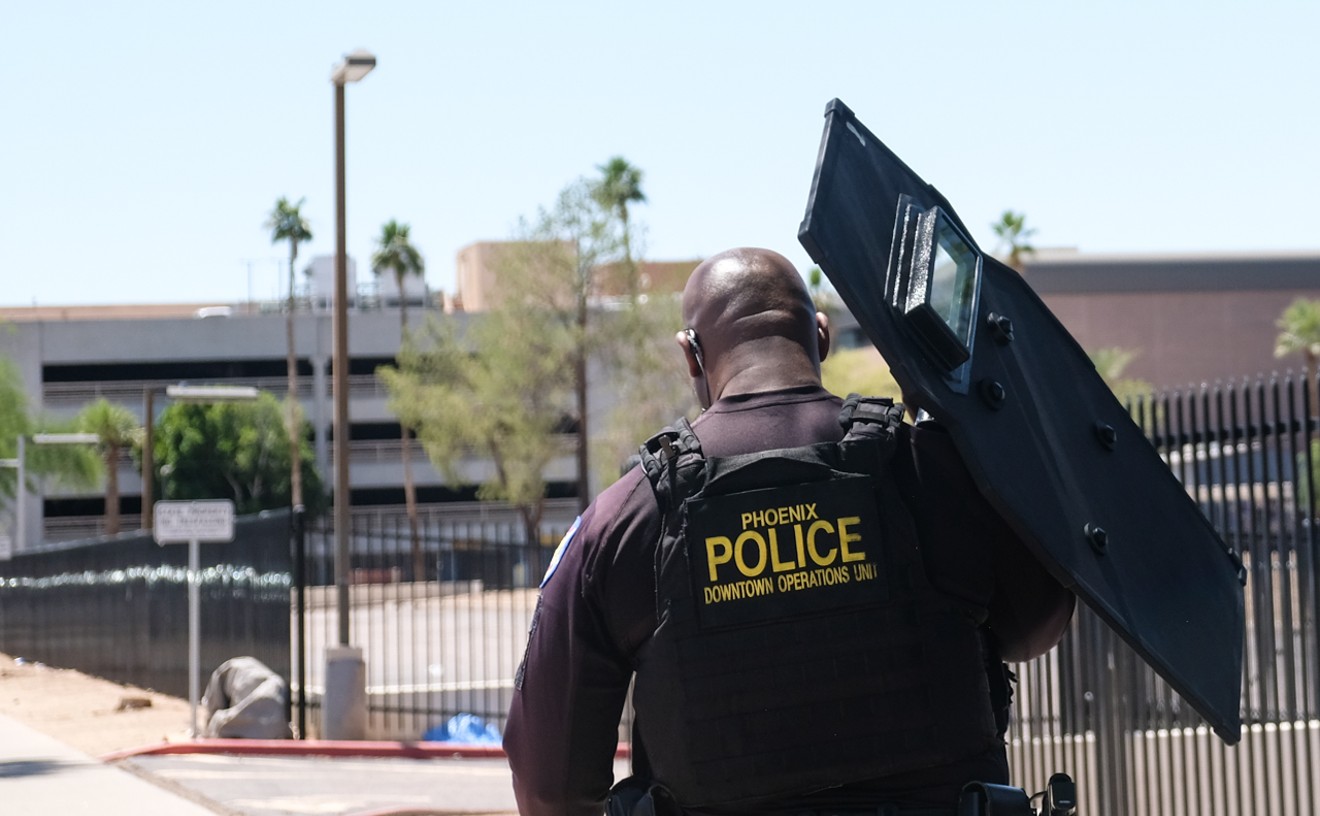Is he another in a long line of Phoenix serial killers?
Our original story begins here:
The last of the leftover Independence Day fireworks were popping on July 6, 2017, the day Aaron Juan Saucedo stood before a judge in a Maricopa County Superior Court.
Saucedo spoke softly: "Not guilty."
Prosecutors say Saucedo shot and killed nine people, mostly strangers, over the course of 10 months. After each attack, they say, he would slip away into the night. Blend in. Change his car and appearance. Hunt different types of prey. Lay low.
To many, he was the Maryvale Shooter, but to police, Saucedo was officially the Serial Street Shooter. Those tracking him likened him to a chameleon.
In court, his days of independence must have seemed over. They weren't letting him out. His trial is still two years off.
That same day, 50 miles away, Cleophus Emmanuel Cooksey, Jr., was incarcerated in the Arizona State Prison in Buckeye. He already had done a 16-year stretch for a deadly armed robbery, been released, violated parole, and was back inside.
But not for long. He could taste independence. Start thinking about what he'd do with it: Reignite his hip-hop venture? Get back with his girl? Something else? On July 28, the gates of Lewis prison opened, and he was free.
Cooksey, police say, shot and killed nine people during three weeks of fury just after Thanksgiving. He knew most of them, they say. Wore one victim's stolen jewelry as a trophy. Used his gun. Bragged of his lust for violence. Made no effort to hide or blend in.

Aaron Saucedo, who faces 20 felony counts including nine murder charges, was like a chameleon, police said.
Maricopa County Sheriff's Office
“Yeah, yeah, yeah, yeah, yeah, motherfucker I’m a monster,” Cooksey intoned on one YouTube hip-hop clip under his performing moniker, King Playbola.
On another clip, he lowers a blue bandana that conceals his face to deliver these lines: “King Playbola, I do, I do, ill / 'Iller than the rest of 'em / Go ask the rest of 'em / I chopped at the rest of 'em / Murdered all the best of 'em.
"Nothing left of 'em / And soon will be the best to come / Kick down the door open, next to come.”
Then Cooksey gently chuckles to himself.
He posted that track two years ago, long before Phoenix police thrust him into a different kind of spotlight. At a press conference Thursday, they named him as chief suspect in the latest spasm of killing to plague Phoenix and nearby cities.
Cooksey, Saucedo, and the Baseline Killer, Mark Goudeau, have now all been connected to nine murders each, the most in Arizona history. The Serial Shooters, Dale Hausner and Samuel Dieteman were convicted of murdering eight between them, primarily during the summer 2006, when they and Goudeau terrorized Phoenix almost simultaneously.
It took months for detectives to unravel those first three sets of serial killings. But this time, aided in part by technology but mostly by a suspect who did little to conceal his actions, the trail quickly got hot.
According to official statements to reporters and documents filed last week, Cooksey announced his deadly presence on Monday, November 27, the night after the Thanksgiving holiday weekend.
Around 10 p.m. on a moonless, cloudy night, Andrew Remillard, 27, sat in a car with his 21-year-old friend Parker Gregory Smith at 1551 East Indian School Road. They were in a parking lot next to a Speedy Cash loan store.
Police responded 47 minutes later to reports of gunfire. They found the two men dead in the car, each shot once in the head. Their killer had fled.
At 11:14 p.m., Cooksey’s cellphone was located on the network a little less than a mile to the south of the shooting.

Andrew Remillard, age 27, and Parker Gregory Smith, 21, were killed on November 27 on East Indian School Road.
Phoenix PD
On Saturday, December 2, police responded to another report of a shooting six miles west down Indian School Road.
It was 7:44 p.m., on a cooler evening. Thirty-five-year-old Salim Richards had been walking through the grounds of the Cove on 44th Apartment complex at 4030 North 44th Avenue. Police found Richards dead and signs of a struggle. The attacker had fled. Witnesses later told detectives Richards and Cooksey knew each other somehow.
Police said Richards’ killer took a 9 mm Glock pistol and a golden necklace during the scuffle.
At 7:40 p.m., a cellphone tower picked up Cooksey’s phone less than 200 yards east of the crime scene. Four minutes after the shooting, the phone was about the same distance to the south.
At 8:26 p.m., somebody used the phone to place an outgoing call from the area. At 8:57 p.m., Cooksey texted someone to say he was at the Circle K two blocks to the west. He and his friend texted each other over the next hour confirming they were nearby.
Around 2:30 a.m., Cooksey posted a photo on his Facebook page showing him sporting a golden necklace like the one Richards wore.
Later, during the autopsy, pathologists pulled bullet slugs from a 9 mm gun that matched the casings from the shooting scene and also matched those from the double murder earlier in the week. Lab technicians found that all were fired from the same pistol.
Much like the earlier killings prosecutors now ascribe to Saucedo in 2015, police did not yet know a predator was on the hunt. The Monster.
Just over a week later, the Monster was on the move. Saucedo, police say, started on familiar ground in central Phoenix not far from the first two shootings they have linked to Cooksey. Then, the Chameleon turned to Maryvale.
Cooksey, police said, moved west, too. To Avondale.
On December 11, at 3:32 p.m., Avondale police responded to a shooting in an apartment at 525 East Harrison Drive. When they arrived, they found 25-year-old Jesus Bonafacio Real dead on a chaise lounge in the bedroom with two gunshot wounds in his face.

On December 11, Avondale police responded around 3:30 p.m. to shots at an apartment complex in the 500 block of East Harrison Drive. There, they found 25-year-old Jesus Bonafacio Real dead.
Phoenix PD
Real had lived there with his two sisters, Griselda and Liliana Vasquez and their kids. The Vasquez sisters answered the door to police.
Detectives scoured the apartment. They noted there were no shell casings. There was a cellphone charger and earbuds next to the corpse, but no phone. It looked to them as if the sisters had tried to tidy up the place.
Detectives asked if anyone had taken anything. Both sisters said no.
During questioning, detectives found out that Liliana had a boyfriend who also lived there. The couple had broken up the night before and the boyfriend had left a couple of hours before the shooting, the sisters revealed.
They also told police that Liliana discovered the body but ran to a nearby Department of Economic Security Office to get Griselda, and together they came back to the apartment, where their brother lay dead. Around that time, they called a third woman, Desaree Monique Coronado, their brother’s girlfriend. She called 911.
Police questioned her, too, about the missing cellphone, and she gave them the same story.
Officers got a search warrant for the phone and traced it to a nearby Super 8 motel two days later. Police staked out the place and found the sisters had the phone. They arrested Coronado there and the sisters elsewhere.
Police charged Coronado and the two sisters, whose stories about the phone and whereabouts of the boyfriend changed during questioning. All three were booked into jail on suspicion of hampering a murder inquiry and tampering with evidence.
Police now had a break. They had a name and a suspect. The boyfriend. Cleophus Cooksey.
As King Playbola, he had waxed lyrical about his girlfriend on a hip-hop YouTube video.
“She my ribbon, my sky / My blessing in disguise / Her beauty is so beautiful / Something that you should know / Baby, you’re my leche / You are everything I need / Baby, you’re my headache that goes away after a long day of makin’ these songs pay,” he said.
Just like when police say Saucedo had stalked and terrorized metro Phoenix in 2015 and 2016, nothing obvious indicated the crimes they later attributed to Cooksey were connected.
Cooksey, police now say, had killed two white men, a black man, and a Hispanic man in central Phoenix and Avondale on the west side. The victims' ages ranged from 21 to 35. By the time Saucedo had slain four people, prosecutors allege in court, he’d shot and killed three Hispanic men, ages, 21, 22 and 61, plus a black woman age 55. He’d also shot at teenagers and an empty house. All along the way, he’d bounced back and forth between central Phoenix and Maryvale on the west side.
Now, as then, police didn’t yet know they were looking for a serial killer. Only later detectives learned that cellphone records showed Cooksey’s phone in the area making a call two minutes before the 911 call.

On December 13, Glendale police responded at 6:53 p.m. to shots near 55th Avenue and Camelback Road. Dead in a parking lot was 29-year-old Latorrie Kayamia Beckford.
Phoenix PD
Too late for Latorrie Kayamia Beckford. And for the Glendale Police Department.
A day earlier, on Wednesday, December 13, Glendale cops got a call at 6:53 p.m. from a woman reporting a man had just been shot outside the door of her apartment at 5038 North 55th Avenue, just north of Camelback Road.
There, on the ground with two bullet holes in his head, lay Beckford, dead at 29.
Witnesses told detectives Beckford lived in the apartment complex and had seen him as they walked to the store moments before two shots rang out. They reported seeing a dark-skinned black man with a thin beard, medium build and average height on the sidewalk where Beckford was dead. The suspect wore a blue T-shirt, blue pants or shorts, and had a blue bandanna over his face.
They recognized him. A guy nicknamed Playboy hung around the apartments, might have lived in one, they said.
Cooksey wore all blue, including a bandanna over his mouth, for many of his hip-hop YouTube videos. He goes by King Playbola on the videos. His prison records list him as 5 feet, 10 inches tall, weighing 220 pounds. His recent mugshot shows a thin goatee.
Once again, detectives scooped up all the physical evidence. It included 9 mm casings from a Luger pistol.
Witnesses said the suspect pointed a semiautomatic handgun at them. They ran and waited for police to show up.
This attack, too, seemed personal. One of the wounds came from a point-blank gunshot, as if Beckford knew his killer. Earlier in the day, witnesses said they’d seen him in an argument with two other men, which may have led to an assault.
Only later did a witness see a photo of Cooksey and finger him as the man who’d gotten in a fight with Beckford hours before the shooting.
The night of the shooting, Glendale had a suspect with a good description and a nickname. Avondale had a name and a suspect. Phoenix had two still seemingly unrelated shootings and no clear suspect.
No one had connected them.
And the Monster had more violence in his blood.
Two days later, on Friday December 15, he struck again, police said. At 7:22 p.m., Glendale police responded to calls of shots at another apartment complex at 5045 North 58th Avenue, just a quarter mile west of the Beckford shooting.

On December 15 at 7:22 p.m., Glendale officers found 21-year-old Kristopher Alexzander Cameron in a field near 58th Avenue and Camelback Road. He died shortly after.
Phoenix PD
It was Cooksey, the officer’s body-cam footage showed later.
Officers rushed to scene of the stricken man, 21-year-old Kristopher Alexzander Cameron, who’d been shot in the neck and abdomen. He was rushed to Thunderbird Hospital where he died within a day.
Police detectives found a 9 mm shell casing next to Cameron’s body. They would later discover the casing matched the bullets and gun from the shooting two nights earlier, and two more incidents to come.
Witnesses said they saw a black man strip Cameron of his backpack. Police found it on a roof.
Police recovered Cameron’s cellphone and starting checking messages. One suggested a meet. It came from Cooskey’s cellphone 14 minutes before the shooting. It, and another text three minutes after the shooting, pinged the nearest cell tower.
Later, Cameron’s girlfriend told investigators he’d arranged to meet someone to sell him half an ounce of pot.
As police were processing the crime scene and interviewing witnesses at the apartment complex, they say the Monster was still on the move, his rage still not slaked.
At 8:31 p.m., just over an hour after the shooting, and a mile-and-a-quarter to the northwest, surveillance cameras at an apartment complex picked up a man matching the same description as Cameron’s killer, ambling aimlessly.
Eight minutes later, the cameras show, Maria Villanueva pulled up in a Kia Sportage to a parking spot near Building 8.
The 43-year-old was there to see her boyfriend.
She didn't get out of the Kia.
Instead, four minutes after she parked, the man from the shooting stood behind the car and started a conversation with her. At 8:50 p.m., Villanueva got out, walked around, and then sat in the passenger seat, as the Monster got in the driver’s seat.
The Kia drove off.

On December 16, Phoenix cops found the body of 43-year-old Maria Villanueva in a south Phoenix alleyway.
Phoenix PD
The Kia was there, too.
Maria Villanueva was 10 miles away, dead in in a South Phoenix alley.
Police arrived at at 1714 South Third Street at 9:45 a.m. They found Villanueva nude from the waist down and shot dead.
She’d been sexually assaulted. A rape kit took DNA and it later matched Cooksey's, police say.
King Playbola had a line eerily resembling the attack, nothing like the sweet love song lyrics about his girlfriend. This one spoke to fornicating in the dirt and leaving a woman to die there. Then: “The first one is righteous. The other will leave you lifeless.”
Bullet casings in the alley matched the 9 mm Glock that had been stolen from Salim Richards in Phoenix two weeks earlier, plus the two shootings in Glendale and another to come in Phoenix.
Back in Glendale, inside Villanueva’s Kia, police had by then found a bloody shirt and a cellphone. Both had Cooksey’s DNA on them, they later learned. The cellphone was listed in Cooksey’s name to an address on Highland Avenue.
That’s where the final chapter of the Monster's rage would play out.

On December 17, Phoenix police responded to shots fired in the 1300 block of East Highland Avenue. That’s where Renee Cooksey, the suspect’s 56-year-old mother, and her husband, Edward Nunn, lay dead.
Phoenix PD
The Monster was spiraling, police say just as they say the Chameleon did, his mind roiling with hate and violence. Police say Saucedo’s last shooting was a triple homicide. They accuse him of shooting two women and a girl in a parked car, just two days after his previous slaying.
The Monster had warned everyone.
“Soon will be the best to come,” he grins in one of his videos.
On Sunday, December 17, Phoenix police took a call about gunshots on Highland Avenue.
The call came from apartments at 1320 East Highland Avenue at 7:50 p.m.
The first thing officers noticed was a large amount of blood on the doorway. The second thing they noticed was Cleophus Cooksey, Jr. The third thing they noticed was his right hand concealed behind his back — a danger sign to any cop.
There was blood on his hands.
Not to worry, Cooksey said, still wearing the golden necklace from a previous killing. The blood was his and he got it from a cut on his hand. See? He showed them.Cooksey raged, telling police that he “controlled the gun,” was going to slit their throats, was “the strongest man alive,” and, bizarrely, that he took care of snitches for Donald Trump.
tweet this
Then he appeared to throw something down the hall behind him, from the concealed hand.
It was time to arrest him.
That’s when the shouting started. Cooksey raged, telling police that he “controlled the gun,” was going to slit their throats, was “the strongest man alive,” and, bizarrely, that he took care of snitches for Donald Trump.
The officers finally tucked the agitated man safely into the back of a squad car. Then they discovered what happened.
Dead from a gunshot wound, inside the apartment, was 56-year-old Renee Cooksey. His mother. And her husband, Edward Nunn, 54.
The Monster ended where the Chameleon began.
Cooksey’s last killing was of his mother and her husband, police say. Saucedo’s first slaying was of his mother’s boyfriend, prosecutors allege. Cooksey’s last shooting was a mile and half from what prosecutors say was Saucedo’s first – a practice drive-by where he fired at an empty house.
After his arrest, Cooksey talked. He told Glendale detectives he recognized Maria Villanueva’s photo and admitted “fooling around with her.” He told them he recognized Kris Cameron and said he’d bought pot from him at a bus stop.
He denied any involvement in their deaths.
He told Avondale police the same.
He admitted being in the area when Jesus Real was shot, but that’s all.
Detectives asked if he knew what had happened.
“Um, something happened. Yeah, I remember,” and then fumbling to recall details, said, “You guys never found anybody.”
He said he didn’t know the name of the dead man, but when police told him they knew about his girlfriend, the break-up, and his presence there, he said, “I should probably talk to my lawyer, right?”
It was much the same in Phoenix. He told detectives he’d been around the area of the murder scenes, but denied having anything to do with them.
He admitted to knowing many, but not all of the victims. Redactions in the court record make it hard to pinpoint those he said he knew.
Still, Cooksey told detectives Jesus Real was like a brother. He never disrespected or stole from Real, who was going to invest in his music business, Fresh to Death Entertainment.
Cooksey told police he’d bought the Salim Richards’ gold necklace from a friend, then from some guy on the street.
One of Richards’ friends identified it.
The full scope of the killing spree didn’t become clear to all three police departments in Phoenix, Glendale, and Avondale, until after the arrest.
Police wove together events largely, but not exclusively, from ballistic evidence. They linked two 9 mm pistols, the Sig Sauer and the Glock, to most, but not all of scenes.
The Sig matched casings in the first two shootings in Phoenix. A bullet was found in the body of Jesus Real, the brother of Cooksey’s girlfriend, but it’s not clear which gun was used. Nor do police say where the Sig came from. Police linked the stolen Glock to the remaining four shootings.
On Thursday, Phoenix authorities bragged how “new technology” allowed them to solve nine murders in three weeks, a feat Sergeant Jon Howard characterized as “outstanding.”
In reality, the technology was old. What was new, because of the Maryvale Shooter case, was the lab work could all be done at Phoenix police headquarters instantly, rather than sending it off and waiting.
“The Serial Street Shooter investigation and others showed us the value of quick analysis. We put the new equipment into use late last year,” Howard told Phoenix New Times.What was new, because of the Maryvale Shooter case, was the lab work could all be done at Phoenix police headquarters instantly.
tweet this
Phoenix police were able to do this with a U.S. Justice Department grant, which enables the city to become of one of five with the National Crime Gun Intelligence Center.
“What once took weeks can now take place in only a matter of hours,” Phoenix Mayor Greg Stanton told reporters.
While true, lightning-fast comparisons of bullets, casings, unique rifling patterns and handgun serial numbers did not stop Phoenix’s latest suspected serial killer. Nor did the teamwork that law enforcement officials bragged about Thursday.
No, the latest suspect was halted when he came to the door of murder scene with blood on his hands, deceit across his face, and a dubious story on his lips.
Two days after Phoenix police took in Cooksey, Glendale police accompanied them on a search of his mother’s home. The same day, Avondale police interviewed him.
Teamwork, and involvement the FBI; the Bureau of Alcohol, Tobacco, Firearms and Explosives, and the combined Violent Crimes Task Force, all made quick sense of the mountain of evidence now assembled. But it hadn’t been clear until after Cooksey was locked up, until after that evidence could be compared, that Cooksey had been behind all the attacks all along, police say and court records show.
Just as at this stage in the Saucedo case, much of the work is still only beginning. Police do not know what drove Cooksey to act. They are still piecing together the relationships between him and each of the victims, and asking the public's help to do so.
Since his arrest, police have searched Cooksey’s property.
At the Highland Avenue apartment where his mother died, police found the blue shirt, pants, and bandanna described in the shooting of Latorrie Beckford in Glendale. Some clothing were stained by what could be blood. Technicians are analyzing it for forensic matches.
They also found a 9mm Glock that matched the casings at four crime scenes.

Cleophus Emmanuel Cooksey Jr., appearing on his hip-hop video "IDGAF" as King Playbola. The video was posted in November 2015, but the clothing resembles some that police link to a series of shootings between Thanksgiving and Christmas 2017.
Screen capture from YouTube
Thursday, the Chameleon and the Monster sort of crossed paths. Police introduced Cooksey's case to the public two hours after a routine pre-trial hearing for Saucedo. The case has been referred to the Maricopa County Attorney’s Office. Neither suspect was present.
Police recommended prosecutors charge Cooksey with nine counts of first-degree murder, one count each of armed robbery, theft of a firearm, kidnapping, sexual assault, and seven counts of parole violations.
As they did after Saucedo’s arrest, police again suggested more victims may be out there and more charges could be pending.
“It’s a distinct possibility and a concern of our investigators,” Howard told reporters.
Asked later to elaborate, he told New Times, “The first shooting was a double homicide. Seems unlikely that a person would be capable of that on their first attempt.”“Crime fame, I only had crime fame. Hey, she filled my brain for my crime name."
tweet this
If police find even one more victim, and a jury finds Cooksey guilty on the charges he will likely face in court, then he would become Arizona’s deadliest serial killer.
“Crime fame, I only had crime fame. Hey, she filled my brain for my crime name,” raps King Playbola on a track he called “Famous.”
He’s famous now.













